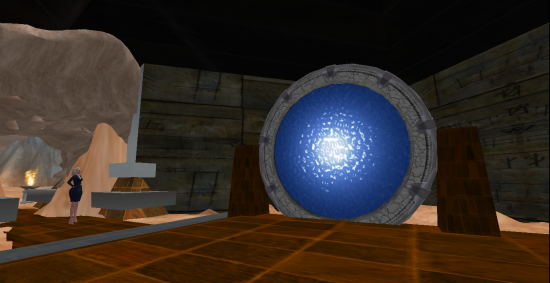OpenSim’s new 0.7.1 release supports meshes, media-on-a-prim, and adds additional security features for grid owners and content creators. The upgrade also promises increased stability and less lag. However, hypergrid teleports are not backwards compatible to previous versions of OpenSim.
Many large public grids have already upgraded to the new version, the first major upgrade in eight months. These grids include OSGrid, GermanGrid, WilderWesten, Jamland, Dorena’s World, Iti Motu, Craft World, Logicamp, OpenVue and several others. Altogether, 16 grids are currently running on the latest version of OpenSim, out of 40 total grids on The Hypergates network.

Grids that have added custom code to their OpenSim software will take longer to upgrade. For example, PioneerX Estates didn’t automatically roll out the new version to its grid management software.

“Because we have custom patches to the code we must make changes before we can put this on our beta grid and hopefully roll it out over our production grids,” PioneerX founder Simon Gutteridge told Hypergrid Business.
However, PioneerX tends to update relatively quickly. Customers aren’t tied to the PioneerX schedule.
While some grids rely on PioneerX for all grid management functions, others, like 3rd Rock Grid, have retained management of their own servers, and are following their own upgrade timetable.

“We are in Beta on 0.7.1 and it is looking good,” grid owner Jim St. Clair (also known as Lazuli Pooraka) told Hypergrid Business. “We likely will upgrade this month or at the latest next month.”
3rd Rock Grid is a closed commercial grid that recently switched over to the PioneerX grid management software, while continuing to host its own regions. (See full story here.)
By comparison, grids that have made substantial changes to the code will not be able to upgrade soon — if at all. For example, InWorldz is running on heavily modified 0.6.5 code, which was released in May of 2009. As a result, the grid can’t take advantage of the work done by the OpenSim community since then and has, instead, been investing in custom development to stay abreast or ahead of mainline OpenSim.
ReactionGrid, which not only runs its own public grid but also many private grids for school and companies, is currently running version 0.6.9, which came out a year ago. Since then, OpenSim has been re-architected for increased stability, and the community has added in-world media, increased hypergrid security, and made many other improvements (see the Release Notes for all the technical details).

“ReactionGrid has been waiting for a formal, stable — in the eyes of the community — 0.7.1 release before starting our work on an upgrade path,” ReactionGrid CTO Chris Hart told Hypergrid Business. “Because we host many small grids, upgrading each and every grid takes a considerable amount of time, but we are still committed to our clients, and our first priority is to providing them a stable environment.”
Different grids have different standards for stability, she added.
ReactionGrid is known for hosting grids for businesses and educational institutions, for whom stability is a primary concern.
“I welcome the uptake and positive reviews of 0.7.1 from the community,” Hart added. “I hope it proves to be as stable for us and the majority of our clients as everyone else.”
ReactionGrid is a little different from many other hosting vendors in that it runs OpenSim on the Microsoft platform, using MSSQL, instead of on Linux and the open source MySQL database.
“We will be working on updating the MSSQL edition of the core OpenSim and providing code back to the OpenSim community as we always have done in the past,” Hart said. “We will then enter the testing phase and work on upgrade strategies.”

An upgrade for the popular Diva Distro version of OpenSim is already available, however, so that users running their own mini-grids on their PCs, laptops or even USB sticks can now upgrade to the latest version using the built-in Upgrade utility. (See details here.) The Diva Distro is a pre-configured version of OpenSim with hypergrid enabled, and designed as a four-region megaregion — no border crossings. It is created and maintained by hypergrid inventor Crista Lopes, a professor at UC Irvine.
Many of the changes in the new release have been available in prior, experimental versions of OpenSim and have been tested and vetted over the past few months. Mesh support, for example, came out last October — just one day after Second Life released it for their experimental grid.
In fact, one of the largest OpenSim grids, Kitely, has been running an experimental version of 0.7.1 since April 20.
“It offers additional important features and fixes some nasty bugs,” Kitely CEO Ilan Tochner said on the company’s Get Satisfaction page.
Altogether, more than 70 bugs have been fixed in the latest release. See the Release Notes for all the technical details.
New content security features
The new release of OpenSim incorporates several features of potential interest to grid owners and content creators. For example, creator names now stay in place when content is transferred across the hypergrid. In addition, creator names can now be preserved with OAR exports of entire regions and IAR exports of user inventories. Previously, objects stored in OARs and IARs came in with the avatar name of the user who uploaded them as creator.
Since avatar names are not unique across the hypergrid — there can be a John Smith on OSGrid, and a John Smith on ReactionGrid, and they might be two different people — the creators names change to something like john.smith@osgrid.org or john.smith@reactiongrid.com, which are unique.
However, the new OAR and IAR files cannot be loaded in by grids running on earlier versions of OpenSim. The reverse works, however — old OAR and IAR files can be loaded by grids running on 0.7.1.
Another security feature is the ability to lock down all content and keep it from leaving a grid or region.
“But for grids it only makes sense to use the same setting for the whole grid, because otherwise you can have regions that are back doors to copy objects outside that grid,” said Dreamland Metaverse‘s Snoopy Pfeffer. “People could go to a region where that feature is disabled to transfer objects to other virtual worlds.”
In addition, avatars traveling out of such grids would show up naked on other grids.
As a result, this security setting would only be useful for grids that only see inbound traffic, and don’t want their visitors to be able to take any content.
“I think a feature that would allow creators to enable exporting per object would be much more useful,” saidPfeffer.
These kinds of fine-grained controls are expected to come in later versions of OpenSim.
Meanwhile, one possible use is to create mini-grids for events, tours or facilities that demonstrate proprietary content. A museum, for example, can use a locked down grid to showcase its virtual content. The museum store or freebie shop would have to be located on a separate grid however — or on a standalone region — connected by a hypergate.
Mesh support
All OpenSim grids running the new 0.7.1 release can now have mesh objects, and save those objects to OAR and IAR export files. However, visitors will need a mesh-enabled viewers such as Second Life’s experimental mesh viewer in order to see them, or upload them.
The release also supports basic mesh physics.
Backwards incompatibility
This new release of OpenSim does not allow for teleports to or from previous versions, even though the version of the hypergrid protocol is the same as in 0.7.0.

“The defacto hypergrid protocol remains HyperGrid 1.5 i7,” OpenSim core developer Justin Clark-Casey told Hypergrid Business.
There were some changes in OpenSim’s implementation, however, that break interoperability, he added. And it’s not just hypergrid teleports that might fail, he said.
“This would affect mixed version grids,” he added.
Hypergrid 1.5 is a more secure version of the hypergrid protocol that protects hypergrid travelers from rogue grid owners interfering with their avatar inventories.
There were no reports of this happening, but it is a security hole in Hypergrid 1.0, the version used in OpenSim 0.6.9 and currently in use by ReactionGrid and other grid running on the old software.
Another hypergrid-related difference with the new release is that hypergrid destination addresses have changed slightly. With Hypergrid 1.0, the hypergrid address was simply the IP address of the computer running the region you wanted to go to, followed by the port number and the region name. As a result, addresses tend to be extremely non-intuitive and difficult to figure out.
With Hypergrid 1.5, this changed to more simple addresses, with the grid’s hypergrid URL and port, followed by the region name — for example, OSGrid’s Lani region is at hg.osgrid.org:80:Lani.
With the latest release, regular URLs are also supported. To teleport to ScienceSim, for example, the hypergrid address is http://grid.sciencesim.com/grid/hypergrid.php.
- OSgrid back online after extended maintenance - April 16, 2025
- Analysts predict drop in headset sales this year - March 25, 2025
- OSgrid enters immediate long-term maintenance - March 5, 2025
